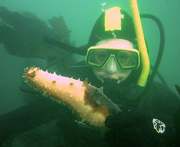Video of Albinism and Leucism in Sea Cucumbers
 Video of escape response when attacked by Pycnopodia sp.
Video of escape response when attacked by Pycnopodia sp.
 Video of a male sea cucumber releasing sperm
Video of a male sea cucumber releasing sperm
 Emily finds a partially albino (pinto?) Parastichopus while diving near Church Island… just up the Strait from Race Rocks.
Emily finds a partially albino (pinto?) Parastichopus while diving near Church Island… just up the Strait from Race Rocks.
DESCRIPTION:
The California Sea Cucumber grows up to 50cm long. They are the largest cucumbers in B.C. waters. They range in colours from red in juveniles to brown or mottled brown, with all white individuals occurring rarely. They are covered on the dorsal side with flesh coloured papillae, and on the ventral side by tube feet. A circle of peltate feeding tentacles surround a subterminal mouth, directed ventrally at the anterior end. Oxygenated water is forcibly pumped into the sea cucumber’s respiratory trees in several successive inhalations, and then deoxygenated water is forcefully expelled. Eye-witness accounts have noted small fish being expelled with this force of water, perhaps living in symbiosis with the California sea cucumber.
RANGE:
Gulf of Alaska to Cedros Island, West of Lower California. Intertidal to 249m. Common on mud, gravel, shell, rock rubble or solid bedrock, from exposed coast to sheltered inlets. Greatest densities occur in quieter waters where organic sediments settle on hard surfaces. Harvesting of Sea Cucumber is also done by divers, throughout their range.
FEEDING, BEHAVIOR, AND BREEDING:
Sea cucumbers feed as they move along the bottom, traveling up to a maximum of 3.9m a day. They gain nutrition from organic material in sediment, mostly form bacteria and fungi. California Sea Cucumbers cease feeding and become dormant from September to early March. Once they reach maturity at four years of age, they will migrate to shallow water to spawn from late April to August, although this timing varies with location. Fertilization takes place in open water. Free swimming larva feed on plankton for 35-52 days before settling to the bottom. Parastichopus californicus has few natural predators. Sunflower starts sometimes eat them, and the sea cucumber reacts strongly by rearing back and flexing violently to avoid being eaten. They are harvested commercially in B.C., Washington, and Alaska for meat, and limits have been set for the amount that may be caught. When disturbed, as other sea cucumbers, it will contract and squirt a powerful stream of water from its posterior end. Five pairs of muscle bands which run the length of the body help this organism in contracting and escape from sea stars. Perhaps one of the most interesting features is this organisms ability to regenerate new organs for winter after expelling them during its dormant phase. It seems there is controversy as to whether sea urchins expel or reabsorb their organs. Recent evidence cited by Philip Lambert of the RBC museum in Victoria(1997) indicates that the sea cucumbers reabsorb their organs.
FURTHER INFORMATION NEEDED:
-further study at Race Rocks of commensal fish living in respiratory tree
-behaviour studies
-colouration, how long it takes to occur in full pigmentation, as a white individual found near Race Rocks has recently begun to change tan colour–later development?
-mechanism of absorbing/ejecting and regenerating organs
WEBSITE LINKS TO SEA CUCUMBERS:
Sea cucumber fishery – Pacific Region
http://www.pac.dfo-mpo.gc.ca/ops/fm/shellfish/Sea_Cucumber/biology_cucumber.htm
A paper by Phil Lambert on Sea Cucumber Taxonomy
http://rbcm1.rbcm.gov.bc.ca/nh_papers//taxing.html
REFERENCES CITED:
Carefoot, Thomas (1977), Pacific Seashores : A Guide to Intertidal Ecology
Lambert, Philip (1997), Sea Cucumbers of B.C., Southeast Alaska and Puget Sound
Morris, Abbott, Haderlie (1990), Intertidal Invertebrates of California
 The Race Rocks taxonomy is a collaborative venture originally started with the Biology and Environmental Systems students of Lester Pearson College UWC. It now also has contributions added by Faculty, Staff, Volunteers and Observers on the remote control webcams. – Sarah Trefry Dec 2001 (PC)
The Race Rocks taxonomy is a collaborative venture originally started with the Biology and Environmental Systems students of Lester Pearson College UWC. It now also has contributions added by Faculty, Staff, Volunteers and Observers on the remote control webcams. – Sarah Trefry Dec 2001 (PC)
| Other Members of the Phylum Echinodermata at Race Rocks |
and Image File |

